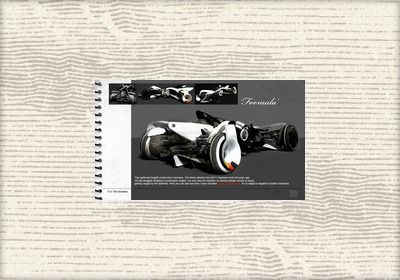Umea Institute of Design degree show 2009
Fri, 17 Jul 2009Masters students from Sweden's Umea Institute of Design recently exhibited their final-year projects at the university's annual degree show. Featuring the work of both graduating diploma students and those completing the first year of their MA in Transportation Design, this year's exhibition brought together a diverse range of themes, ranging from futuristic interpretations of existing brand DNA to new concepts in car production, usage and forms. These are the highlights.
Diploma students:
Bugatti Morpheus
Doojin Choi
Designed for the year 2050 - a time when congestion forces drivers to take to circuits and areas of desert for thrills - the Morpheus concept takes the Bugatti Veyron's hunched-forward, beetle-like proportions and evolves them into an even more extreme single-seat speedster form designed purely for track day use.
The driver sits on an outrigger section that hangs on the right side between the front and rear wheels, creating an unusually open driving experience. Other unusual features such as the exposed structure, bespoke luggage set and the large spare wheel attached to the middle add a futuristic twist to design cues that date back to the birth of the Bugatti brand, not to mention a welcome dash on humour on the part of its South Korean creator.
Citroën Dakar Rally Vehicle
ChuHyung Kwon
Kwon's Citroën Dakar Rally Vehicle updates the concept of an endurance rally raid vehicle for the year 2020. At the core of this unusual design is the car's ‘structural skin' - an inventive approach to holistic design that sees the exterior upper surface of the car act as a shock absorber during the inevitable tumbles that occur during competitive rallying.
Constructed from AeroGel, carbon-Kevlar composite and liquid metal, this interlocking upper body layer actively spreads the force of impact throughout its surface, minimizing the chance of serious occupant injury. Other systems such as self-righting, pit climbing and modular tires are designed to keep the car moving and intact regardless of conditions.
Mercedes Cyborg Sensation Vehicle
Chik Kin Ng
Unusually, this two-seat off-roader concept is designed for use by "the professional cyborg" of the year 2040. Dubbed the Cyborg Sensation Vehicle, it uses a new kind of driver interface to allow its cybernetic pilot to control it by thought alone, wirelessly relaying information and commands from machine to machine. Somewhat ironically, the form itself is inspired by human muscle and skeletal structure, employing artificial muscles that connect the main body structure to the car's extruded wheel housings. This vision for the future of the Mercedes brand also features a 360-degree viewing canopy for maximum driver enjoyment.
Breathe
Chansong Park
Breathe is a futuristic multi-model concept designed to satisfy the needs of people dwelling in a metropolis in the year 2038. By combining memory shape alloys for the exterior construction and an inflatable interior balloon that reshapes according to use (via the passing of an electric current), this innovative monoform concept can transform into three distinct shapes and uses: single-person commuter mode, public transportation mode, and delivery vehicle mode. In public transportation mode the vehicle circulates around a pre-designated route through the city, waiting to be hailed by passersby.
Anything Moves a Bucket of Lilies
Marcos Costa
Taking a holistic, back-to-basics approach to vehicle design inspired by Alec Issigonis's iconic original Mini, ‘Anything Moves a Bucket of Lilies' explores the increasingly popular idea that sustainable transport can only be brought about by rethinking the way that cars are produced, delivered and disposed of. Consisting of just two major components - an upper moulded body tub on to which seats, roof rails and so on can be affixed; and a lower moulded tub in which the electronics and battery module is stored, and to which the combined wheel-and-suspension assemblies are attached - this two-seat buggy concept forgoes the need for welding or painting, and can therefore be assembled locally rather than being ‘manufactured' and shipped from long distances.
Continues →
By Euan Sey

